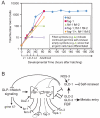Scratching the niche that controls Caenorhabditis elegans germline stem cells
- PMID: 19765664
- PMCID: PMC2820558
- DOI: 10.1016/j.semcdb.2009.09.005
Scratching the niche that controls Caenorhabditis elegans germline stem cells
Abstract
The Caenorhabditis elegans gonad provides a well-defined model for a stem cell niche and its control of self-renewal and differentiation. The distal tip cell (DTC) forms a mesenchymal niche that controls germline stem cells (GSCs), both to generate the germline tissue during development and to maintain it during adulthood. The DTC uses GLP-1/Notch signaling to regulate GSCs; germ cells respond to Notch signaling with a network of RNA regulators to control the decision between self-renewal and entry into the meiotic cell cycle.
Figures



References
-
- Schofield R. The relationship between the spleen colony-forming cell and the haemopoietic stem cell. Blood Cells. 1978;4:7–25. - PubMed
-
- Kimble JE, White JG. On the control of germ cell development in Caenorhabditis elegans. Dev Biol. 1981;81:208–19. - PubMed
-
- Kimble J, Crittenden SL. Controls of germline stem cells, entry into meiosis, and the sperm/oocyte decision in Caenorhabditis elegans. Annu Rev Cell Dev Biol. 2007;23:405–33. - PubMed
-
- Xie T, Li L. Stem cells and their niche: an inseparable relationship. Development. 2007;134:2001–6. - PubMed
-
- Dinneny JR, Benfey PN. Plant stem cell niches: standing the test of time. Cell. 2008;132:553–7. - PubMed
Publication types
MeSH terms
Substances
Grants and funding
LinkOut - more resources
Full Text Sources
Medical

